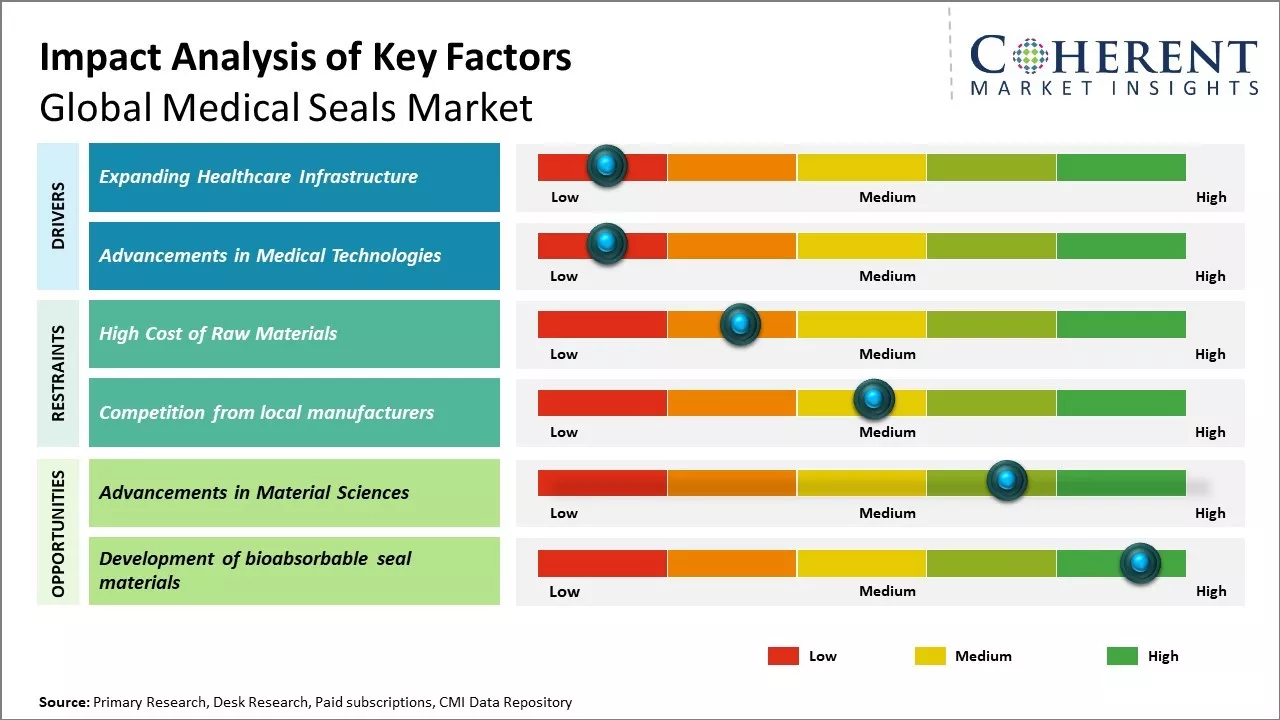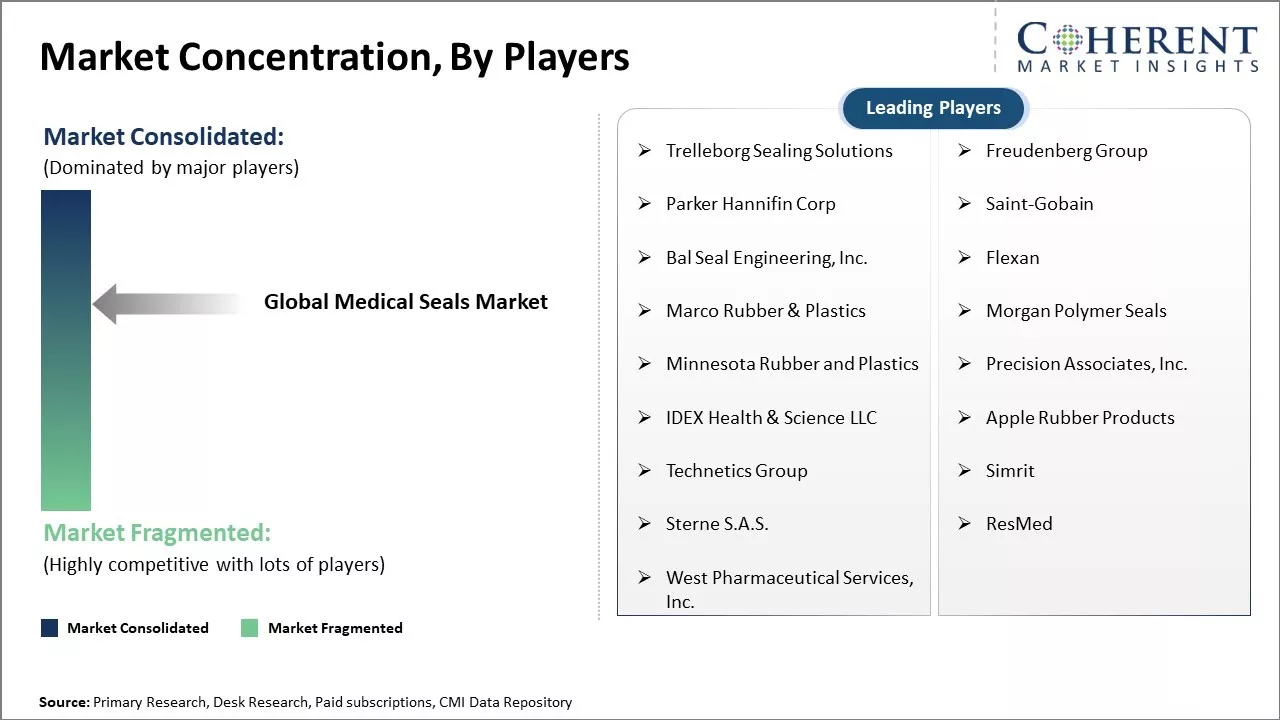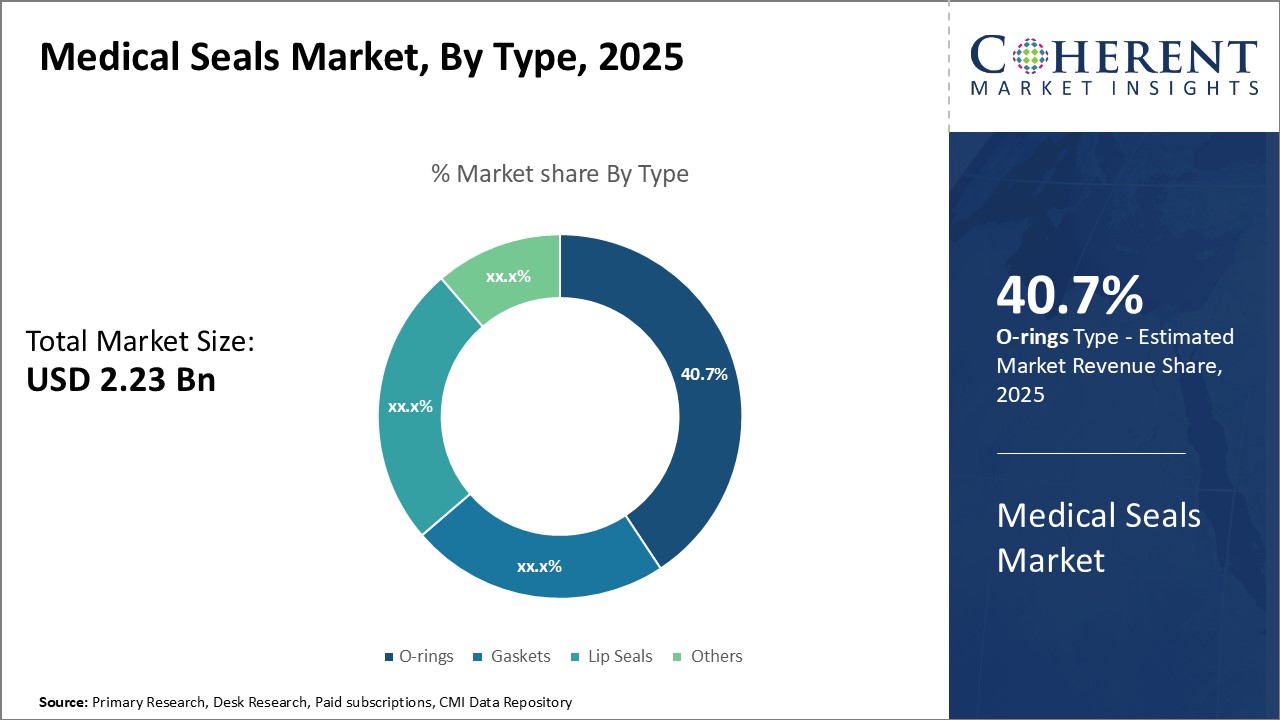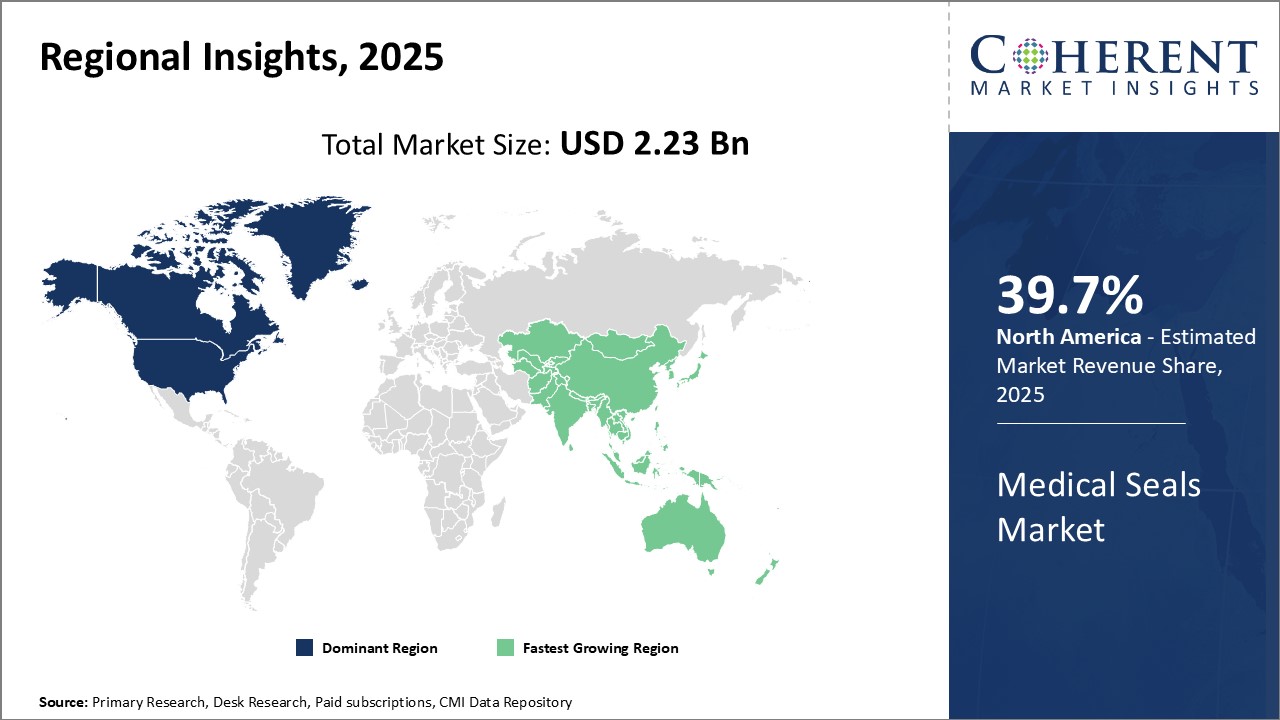Medical Seals Market Size and Trends
The global medical seals market is estimated to be valued at USD 2.23 Bn in 2025 and is expected to reach USD 3.45 Bn by 2032, exhibiting a compound annual growth rate (CAGR) of 6.4% from 2025 to 2032.

Discover market dynamics shaping the industry: Download Free Sample
The medical seals market is expected to witness significant growth over the forecast period. The increasing demand for medical devices across various applications, such as medical equipment, devices, and accessories, is supporting the growth of the medical seals market. Additionally, the increasing healthcare spending worldwide and focus on the upgradation of healthcare infrastructure is also fueling the demand for medical devices, which, in turn, is driving the need for seals that provide leakproof fittings in medical devices and equipment. However, stringent regulatory approvals for medical seals may hamper the market growth. Innovation and development of advanced sealing materials to improve efficiency and compatibility are expected to create potential opportunities for the players operating in the market during the forecast period.
Expanding Healthcare Infrastructure
The global medical seals market is expected to witness significant growth in the coming years. This can be attributed to the growing investments in healthcare infrastructure development across both developed and developing regions. Governments around the world are focused on improving their public healthcare systems through various initiatives. This includes expansion and modernization of existing hospitals as well as setting up new medical facilities. The growing healthcare infrastructure leads to increasing demand for various medical equipment and devices that require seals for their proper functioning. Seals play a crucial role in devices used for surgeries, diagnostics, patient monitoring and various other critical applications. With more hospitals, clinics and medical laboratories coming up, the consumption of seals is expected to rise substantially. For instance, in May 2025, Healthcare Global Enterprises Limited (HCG) expanded its cancer care network in Bengaluru, India with two new centers in Whitefield and North Bengaluru, set to open in early 2025. These centers will provide comprehensive cancer care, including advanced treatments like the MR LINAC radiation system. HCG also plans to add two new day care centers in Bengaluru, India to improve the accessibility for patients needing chemotherapy.
Market Concentration and Competitive Landscape

Get actionable strategies to beat competition: Download Free Sample
Advancements in Medical Technologies
Another key factor propelling the medical seals market is the continuous advancements happening in the field of medical technologies. Rapid digitization and introduction of innovative technologies are transforming the healthcare sector. There is a widening application scope for seals with the development of new generation medical devices, diagnostics equipment, and implantable products. For instance, minimally invasive surgeries are gaining preference over traditional open surgeries due to benefits like smaller incisions, lesser pain, and quicker recovery times. This has boosted the use of seals in devices like trocars, cannulas, and staplers used in laparoscopic procedures. Similarly, advancements in drug delivery systems such as pre-filled syringes, injectors, and auto-injectors are driving the demand for seals that help in maintaining sterility and ensuring accurate dosing. Even sectors like prosthetics, dentistry, and ophthalmology have emerged as new attractive application areas with technological developments in these areas. All such advancements will continue promoting the use of high-performance seals that seamlessly function under varying conditions.
Key Takeaways from Analyst:
The global medical seals market shows promising growth opportunities over the next five years. Rising chronic disease prevalence and increasing investments in healthcare infrastructure development across major regions will likely drive the demand for various medical devices. This, in turn, will boost the need for medical seals which are used extensively in medical equipment for their fluid sealing and protective functions. North America and Western Europe will remain dominant regions owing to the presence of leading medical device OEMs and higher adoption of advanced medical technologies. However, Asia Pacific is expected to emerge as the fastest growing market with the expanding medical tourism industry and growing focus on quality healthcare provision in countries like China, India, and South Korea.
Cost-competitiveness of Chinese and Indian seal manufacturers could also weaken competitive positions of some established players. Material innovations bringing advancements like higher biocompatibility, precision molding capabilities and enhanced fluid resistance will support market trends toward miniaturization and complexity in device design. Nonetheless, pricing pressures and rigid quality and safety standards remain challenges. Moreover, political and economic uncertainties may impact discretionary healthcare expenditures in certain markets. Overall, the opportunities appear skewed towards specialized material variants, aseptic product lines and offerings matched to rising non-invasive procedures. Regional expansion strategies and collaborations to access emerging growth avenues will be critical for longer-term success.
Market Challenges: High Cost of Raw Materials
The rising costs of raw materials is a significant challenge restraining the growth of the global medical seals market. Medical seals are crucial components used across several medical devices and equipment to prevent the leakage of fluids or ingress of contaminants. They are manufactured using various polymers, elastomers, and metals which have witnessed substantial increase in their prices in recent years.
For example, according to World Bank commodity price data, the average price of titanium, a key metal used in medical device seals, increased by over 35% between 2020 and 2022. Similarly, natural rubber which is widely utilized for making silicone rubber seals saw its prices climb by almost 30% during the same period according to UNCTAD, United Nations Conference on Trade and Development statistics. The hike in commodity costs is attributed to multiple macroeconomic factors like disruptions in global supply chains due to the pandemic, high inflation rates, ongoing war between Ukraine and Russia aggravating energy, and food crises across regions. With raw materials accounting for a significant portion of the overall manufacturing expenses for medical seals, the steep rise in their input costs is shrinking profit margins for companies.
Market Opportunities: Advancements in Material Sciences
Advancements in material sciences hold huge opportunities for the global medical seals market in the coming years. The modern healthcare industry requires highly-engineered sealing solutions that can deliver long-lasting performance in challenging environments. Novel materials that are biocompatible, sterilizable, and offer superior chemical resistance can help medical device manufacturers make their products more safe, reliable, and versatile. Currently, silicone remains one of the most widely used materials for medical seals due to its flexibility, stability under heat and radiation, and non-reactivity to bodily fluids and tissues. However, researchers are exploring newbreed biomaterials made from polymers and plant-based compounds that replicate human tissues. For example, nanocellulose extracted from wood fibers is being developed into durable, pliable and non-allergenic films and coatings for devices. Similarly, advancements in functionalization of thermoset polymers allow embedding antimicrobial properties and improving their surface properties at nano-scale. Such materials drastically reduce risks of infection and rejection in implants.

Discover high revenue pocket segments and roadmap to it: Download Free Sample
Insights by Type - O-rings dominate due to favorable properties
In terms of type, O-rings is expected to contribute the highest share of the market with 40.7% in 2025 owing to its versatile properties suitable for various medical applications. O-rings feature exceptional sealing ability due to their closed cross-sectional design. The circular shape allows O-rings to form leak-proof seals around shafts, pistons, and other cylindrical parts common in medical equipment. Their elastic nature enables easy installation without damaging delicate components. O-rings also demonstrate great longevity and withstand wear and tear over many usage cycles. The uniform seal they provide protects medical devices from liquid, gas, and particle intrusion to ensure proper functioning. Their availability in various elastomer formulations like silicone rubber allows compatibility with diverse fluids handled by medical equipment without reactions. O-rings' cost-effectiveness compared to alternatives further boosts their preference among medical device manufacturers.
Insights by Material - Superior biocompatibility drives silicone dominance
In terms of material, silicone is expected to contribute the highest share of the market with 25.6% in 2025 owing to its outstanding biocompatibility. Silicone demonstrates excellent tissue and blood compatibility making it suitable for applications involving patient contact. Its inherent properties prevent cell and protein adhesion, thrombosis, and inflammation. Silicone is non-toxic and does not leach out harmful substances. It maintains properties within a wide temperature and chemical range encountered during sterilization and medical procedures. Silicone's elasticity enables dynamic sealing of irregular surfaces without breakage. It resists moisture and microbial ingress critical for maintaining aseptic conditions. Excellent thermal stability of silicone extends product lifetime. Its self-lubricating nature eases component movement for improved functionality. Overall, silicone's biostable nature and performance reliability have established it as the material of choice for critical medical sealing needs.
Insights by Application - Equipment applications demand stringent sealing
In terms of application, medical equipment is expected to contribute the highest share of the market with 35.71% in 2025 due to their extensive and complex sealing requirements. Medical equipment interacts with numerous bodily fluids and gases posing high risks of contamination without precise sealing. They contain complex mechanical assemblies operating under demanding operating conditions requiring seals resistant to chemicals, particulates, pressure, and temperature extremes. Seals must withstand rigorous cleaning cycles involving harsh chemicals during equipment reprocessing. Medical equipment are used for critical diagnostic and therapeutic procedures where even miniscule fluid leaks can have grave consequences necessitating hyper-reliable seals. Stringent regulations governing equipment design and functionality further emphasize the need for seals meeting biocompatibility and performance standards. Therefore, medical equipment manufacturing spearheads technological advancements in high-performance seals to ensure patient safety.
Regional Insights

Need a Different Region or Segment? Download Free Sample
North America has dominated the global medical seals market. The region is expected hold a market share of 39.7% in 2025 due to the strong presence of large medical device manufacturers in the region. The U.S. accounts for the majority of the North American market share due to the size of its healthcare industry and demand for various medical devices. Several leading medical seals manufacturers such as Saint Gobain, IDEX Corporation, and Freudenberg have sizable operations across the U.S. and Canada to primarily serve the domestic demand as well as support exports. These companies offer a wide range of sealing solutions made from varied materials such as elastomers, plastics, and metals to suit diverse requirements of the medical industry. Moreover, North America being an early adopter of advanced medical technologies has fueled consistent demand growth for high-performance seals that can withstand stringent sterilization processes.
The Asia Pacific region has emerged as the fastest growing regional market for medical seals in recent times. China plays a pivotal role in propelling the Asia Pacific market owing to its large population size and rapid economic growth over the past two decades which has tremendously expanded domestic healthcare spending. Considerable foreign investments by global medical device majors have also boosted local manufacturing capabilities in China. This has enhanced the demand for medical-grade seals from both international as well as domestic original equipment manufacturers (OEMs) present in China. Besides China, other Asian countries like India, Indonesia, Vietnam, and Thailand are progressively augmenting their healthcare infrastructure that requires medical equipment wired with precision-engineered seals. Additionally, these developing nations have become attractive manufacturing hubs for medical device exports, thus driving the local consumption of seals.
Market Report Scope
Medical Seals Market Report Coverage
| Report Coverage | Details | ||
|---|---|---|---|
| Base Year: | 2024 | Market Size in 2025: | USD 2.23 Bn |
| Historical Data for: | 2020 To 2024 | Forecast Period: | 2025 To 2032 |
| Forecast Period 2025 to 2032 CAGR: | 6.4% | 2032 Value Projection: | USD 3.45 Bn |
| Geographies covered: |
|
||
| Segments covered: |
|
||
| Companies covered: |
Trelleborg Sealing Solutions, Freudenberg Group, Parker Hannifin Corp, Saint-Gobain, Bal Seal Engineering, Inc., Flexan, Marco Rubber & Plastics, Morgan Polymer Seals, Minnesota Rubber and Plastics, Precision Associates, Inc., IDEX Health & Science LLC, Apple Rubber Products, Technetics Group, Simrit, Sterne S.A.S., ResMed, and West Pharmaceutical Services, Inc. |
||
| Growth Drivers: |
|
||
| Restraints & Challenges: |
|
||
Uncover macros and micros vetted on 75+ parameters: Get instant access to report
Medical Seals Industry News
- In January 2024, Freudenberg Sealing Technologies, a medical device company, secured a new purchase agreement with Ypsomed, a Swiss medical technology specialist, for seals used in insulin pumps. The increased order volume significantly surpasses previous levels, highlighting Freudenberg Sealing Technologies' strong reputation for reliability and expertise in the medical technology sector.
- In November 2023, Ethicon, a Johnson & Johnson MedTech company, launched ETHIZIA, Hemostatic Sealing Patch, an innovative hemostat designed for challenging bleeding scenarios. This synthetic polymer technology is the first hemostatic matrix to be equally effective on both sides, offering sustained hemostasis.
- In January 2022, Henkel, Chemicals company launched three new low-pressure molding (LPM) materials aimed at sealing and safeguarding medical devices against environmental challenges such as moisture, temperature variations, chemicals, vibration, and impact. Loctite PA 6732, Loctite PA 6682, and Loctite PA 6951 utilize a gentle, low-pressure process to fully encapsulate a range of medical devices.
- In July 2021, Medcura, Inc., a medical device company, in collaboration with ASO, LLC, a prominent U.S.-based manufacturer of first aid products, introduced Rapid-Seal, an advanced antibacterial hemostatic gel
*Definition: The global medical seals market refers to the market for sealing components that are used in various medical devices and equipment to prevent leaks, create seals, or isolate contamination. Medical seals are employed in medical equipment to isolate pharmaceutical, biological, and other medical fluids from external contamination. They help maintain sterility and integrity of devices used for providing healthcare. Common medical sealing applications include components in syringes, IV & blood collection systems, medical tapes, and wound care products.
Market Segmentation
- Type Insights (Revenue, USD Bn, 2020 - 2032)
- O-rings
- Gaskets
- Lip Seals
- Others
- Material Insights (Revenue, USD Bn, 2020 - 2032)
- Silicone
- Metal
- Polytetrafluoroethylene (PTFE)
- Nitrile Rubber
- Ethylene propylene diene terpolymer (EPDM)
- Others
- Application Insights (Revenue, USD Bn, 2020 - 2032)
- Medical Equipment
- Dental Equipment
- Medical Devices
- Others
- Regional Insights (Revenue, USD Bn, 2020 - 2032)
- North America
- U.S.
- Canada
- Latin America
- Brazil
- Argentina
- Mexico
- Rest of Latin America
- Europe
- Germany
- U.K.
- Spain
- France
- Italy
- Russia
- Rest of Europe
- Asia Pacific
- China
- India
- Japan
- Australia
- South Korea
- ASEAN
- Rest of Asia Pacific
- Middle East
- GCC Countries
- Israel
- Rest of Middle East
- Africa
- South Africa
- North Africa
- Central Africa
- North America
- Key Players Insights
- Trelleborg Sealing Solutions
- Freudenberg Group
- Parker Hannifin Corp
- Saint-Gobain
- Bal Seal Engineering, Inc.
- Flexan
- Marco Rubber & Plastics
- Morgan Polymer Seals
- Minnesota Rubber and Plastics
- Precision Associates, Inc.
- IDEX Health & Science LLC
- Apple Rubber Products
- Technetics Group
- Simrit
- Sterne S.A.S.
- ResMed
- West Pharmaceutical Services, Inc.
Share
Share
About Author
Manisha Vibhute is a consultant with over 5 years of experience in market research and consulting. With a strong understanding of market dynamics, Manisha assists clients in developing effective market access strategies. She helps medical device companies navigate pricing, reimbursement, and regulatory pathways to ensure successful product launches.
Missing comfort of reading report in your local language? Find your preferred language :
Transform your Strategy with Exclusive Trending Reports :
Frequently Asked Questions
EXISTING CLIENTELE
Joining thousands of companies around the world committed to making the Excellent Business Solutions.
View All Our Clients
